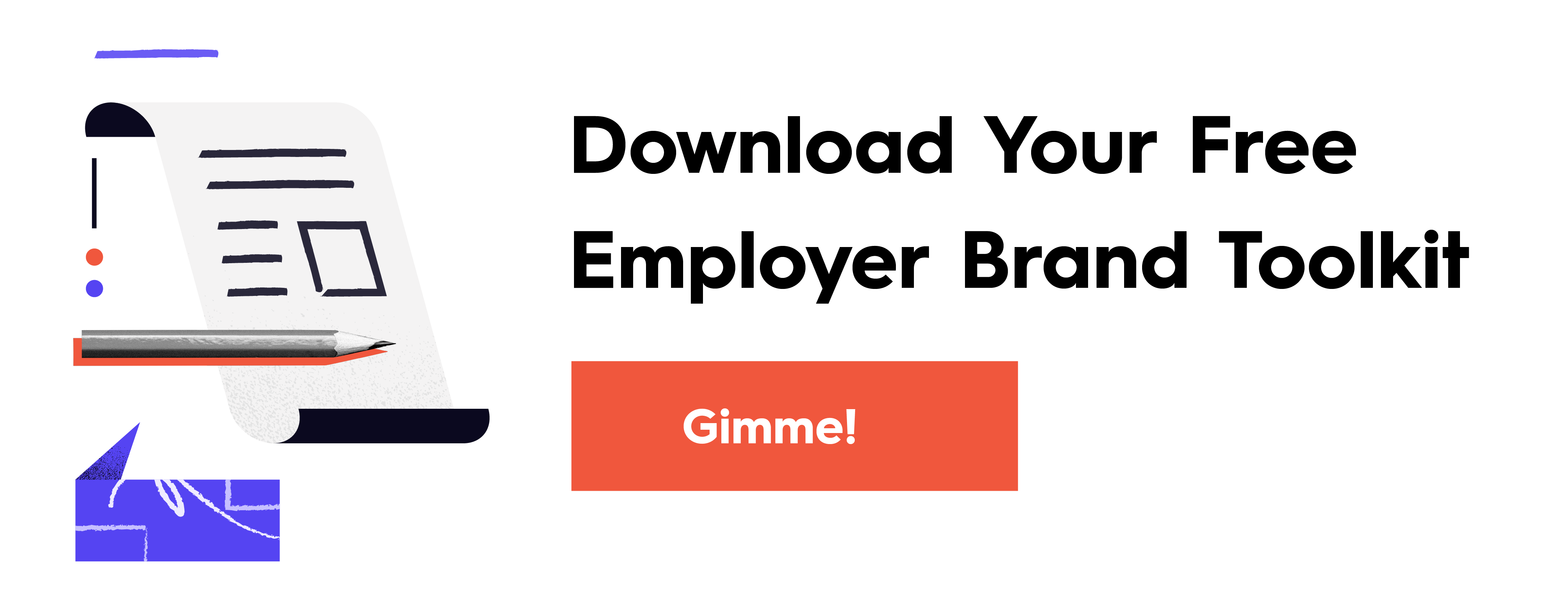If you’re going to put work into growing your employer brand, nurturing your culture, and sharing that story, you want to know that your efforts are paying off. And if they’re not, you want to know how to make sure they do. But without an understanding of what success looks like, you’ll stay in the dark.
We don’t want you to waste any of your hard work (and miss out on potentially great hires in the process), so today we’re helping you figure out how to measure your employer brand at every stage of the employee journey. From awareness to post-employment, we’ve compiled the most helpful metrics to determine how well you’re connecting with prospective employees, keeping current employees engaged, and hitting your goals.

What You Need to Measure Your Employer Brand
Remember that without the right strategy and infrastructure in place, you won’t be able to move the needle, no matter how much data you track. So, before we dive into the concrete ways you can measure your employer brand, we have a few tips to set you up for success from the jump.
- Know your goal. The whole point of tracking is to understand your strengths and weaknesses and identify ways to improve. Before you worry about what you’re going to measure, make sure you have clarity about why you want to measure at all.
- Prioritize your metrics. You don’t have to measure every little thing. Focus on the areas where you want to make the biggest strides. For example, if you have a strong employee retention rate but you’re lacking diversity in candidates, focus on ways to track and improve those metrics.
- Set up the right tools to track. Are your Google analytics connected to your application software? Are your platforms optimized? Are you familiar with your dashboards? Many platforms have a variety of tools built in, so make the most of what’s available to you, and fill in the gaps where you need to.
[bctt tweet=”The better you measure your employer brand, the more successful you’ll be. ” username=”columnfive”]
How to Measure Your Employer Brand
Your employer brand isn’t just about how you recruit, or what benefits you offer. Everything from your job descriptions to your culture influences how people perceive your brand. Thus, it’s important to measure how you’re doing at every stage of the employee journey.
96% of companies believe employer brand and reputation can positively or negatively impact revenue, but only 44% monitor its impact.
Here, we’ve outlined some of the most insightful data to track for each stage. As previously mentioned, you don’t have to track every little thing, but it’s helpful to choose 2-3 main KPIs from each stage that will help you get a sense of your whole employer brand. This will help you understand where you need to make adjustments, and how you’re improving over time.
Note: Some of these recommendations may be more qualitative than quantitative. We always prefer hard data, but any insight or feedback can be helpful to measure your success.
Stage 1: Awareness
At this stage, you want to measure your reach to understand how well you’re connecting with people, what they’re interested in, and how you can better tailor content to capture their interest.
For example, if you notice that people really enjoy your culture content on Instagram, you may want to tweak your ads to showcase your people.
Metrics:
- Job posting views and shares
- Company profile views on job search sites
- Ad click-throughs
- Social followers and engagement
- Website visits to your Careers page (or related content)
- Visits/engagement with employer brand content
Stage 2: Consideration
The wider your reach, the more prospective job candidates you can attract. These metrics are crucial to help you understand not only just how wide your reach is but who you’re really speaking to.
For example, if you’re looking to reach a more diverse group of people, you may find the traditional platforms you’re using are not particularly effective.
Metrics:
- Number of applicants
- Diversity of applicants
- Number of qualified applicants
- Employee referrals
Stage 3: Decision
The whole point of investing in your employer brand is to attract—and keep—the best talent. These data points will give you insight into how well you have advertised (and followed through) on your employer brand.
For example, if you find that you have plenty of diverse candidates, but you have a low acceptance rate, you may not be emphasizing your commitment to diversity and inclusion in your content or conversations with candidates.
Metrics:
- Acceptance rate
- Time to hire
- Quality hires
- Cost per hire
- Diversity of hires
Stage 4: Retention
This is usually the more challenging part of employer branding. Keeping people interested, engaged, and satisfied isn’t easy, but understanding how people are feeling (and what might be influencing that) is crucial for your long-term success.
For example, if you notice an unusually high rate of new-hire turnover, you may be overpromising or misrepresenting your employer brand during the hiring process.
Metrics:
- Employee engagement satisfaction
- Promotions
- Retention
- Turnover (voluntary/involuntary)
- Average tenure
- Glassdoor reviews and ratings
- Pay parity (gender, ethnicity, etc.)
- Engagement with employee-generated content
Stage 5: Post-Employment
Naturally, you want people to stay with your company. But your employer brand relationship doesn’t end when employees put in their two weeks’ notice. Understanding how former employees feel about your brand is incredibly relevant and insightful.
For example, you may notice you’re losing employees to the same competitor, or for a similar reason (e.g., dissatisfaction with company direction).
Metrics:
- Reason for leaving
- Exit interview feedback
- Willingness to refer
- Number of alumni referrals
- Glassdoor reviews and ratings
How to Nurture Your Employer Brand
The more consistently and effectively you track your progress, the more you can come up with smart strategies to improve on your weaknesses. If you’re looking for ways to strengthen your brand…
- Do an audit. Sometimes it’s hard to get an accurate picture of your employer brand. Use this template to interview prospective, current, and former employees to find out what they really think about you.
- Find out what your competitors are doing. Conduct an employer competitive analysis to identify ways you can stand out.
- Map your employee experience. Our guide will help you understand which stories people need to hear at each stage to go from passive candidate to active, engaged employee.
- Invest in your culture. See our guides to improve the core pillars of your culture, strengthen your remote team, and turn your culture into interesting content.
Most of all, be patient. Building a brand doesn’t happen overnight; it takes time, commitment, and persistence. But if you’re stuck in a rut or looking for more ways to nurture your employer brand, let’s talk about how we can help you grow the right way.





